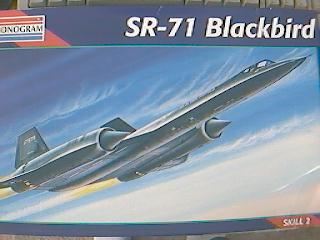
|
KIT: |
Monogram 1/72 SR-71 & Drone |
|
KIT # |
5810 |
|
PRICE: |
$14.00 |
|
DECALS: |
2 aircraft |
|
REVIEW & |
Ron Guerra |
|
NOTES: |
Includes D-21 Drone |

|
HISTORY |
Built largely from titanium, called "Blackbird" by many and "Habu" by the inhabitants of Okinawa because of its resemblance to a native cobra of the same name, the SR-71 is well known as the fastest jet-engined aircraft put into production. This impressive machine cruised at three times the speed of sound while photographing 100,000 square miles over the course of one hour. The aircraft circulated its JP-7 fuel through various systems to help cool itself and could have theoretically flown at Mach 4, but it was specifically designed to fly around Mach 3.2 and at an altitude of 80,000.
After retirement from the U.S. Air Force, two SR-71's were used by NASA for different experiments involving the study of materials exposed to high speeds and high temperatures. In some cases, the aircraft were also used to observe objects in outer space that can not be studied as easily from instruments on the ground.
The Lockheed D-21 Unmanned Aerial Vehicle was developed to undertake reconnaissance missions at high speed of Mach 3+ after being launched from an M-12 (an aircraft similar in appearance to an SR-71). Its first powered flight was in 1966. However only a few missions were flown using the M-12 carrier aircraft because of a fatal accident that occurred when a D-21 impacted with an M-12 after a launch. Later D-21 flights were accomplished using a B-52 as a carrier aircraft. The D-21's mission details are apparently still secret...
As far as I can tell, the D-21 drone was never launched from an SR-71, only from the M-12, so posing the 2 models in a piggy-back configuration is inaccurate, though it does look impressive (look here for an image of the actual M-12/D-21 combination: http://www.wvi.com/~lelandh/srqt~1.htm).
|
THE KIT |
I built this kit years ago and opening the box revealed a familiar sight. This reboxing from 1995 contains 66 parts molded in black and clear plastic. The clear pieces are sufficiently thin and only a little distorted. The 18-step directions dated from 1984 provide a brief history of the 2 aircraft in English. Painting information is given in basic colors (olive drab, red, gray, orange, yellow, etc.)
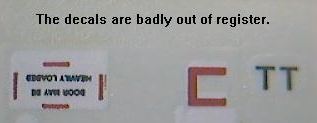 The decal sheet provides markings for 2 aircraft, but the
decals in my sample were printed badly out of register and most serious modelers
will try to find some substitutions. All of the single-color (white) decals will
certainly be usable though. As I recall, when I built my first Monogram SR-71 a
long time ago and didn't care about things like misprinted decals (or filling
seams!), I applied the them to bare, unpainted plastic and they never silvered.
The decal sheet provides markings for 2 aircraft, but the
decals in my sample were printed badly out of register and most serious modelers
will try to find some substitutions. All of the single-color (white) decals will
certainly be usable though. As I recall, when I built my first Monogram SR-71 a
long time ago and didn't care about things like misprinted decals (or filling
seams!), I applied the them to bare, unpainted plastic and they never silvered.
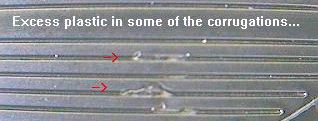 The 2 canopies may be posed opened or closed and the D-21 can
be placed on the included service cart or mounted on the back of the SR-71 using
an optional pylon part.
The 2 canopies may be posed opened or closed and the D-21 can
be placed on the included service cart or mounted on the back of the SR-71 using
an optional pylon part.
Now, let's look at the SR-71 itself first. With the exception
of the characteristic corrugations on the upper and lower surfaces of the
aircraft and the control surface lines, all other panel lines are raised. Some
of the corrugations are spoiled 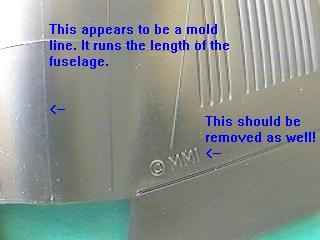 by excess plastic--perhaps this is due to mold
damage. A faint but obvious mold line runs the entire length of the upper and
lower aircraft halves. There is a modest amount of flash on some of the parts,
but most of it can be cleaned up pretty easily.
by excess plastic--perhaps this is due to mold
damage. A faint but obvious mold line runs the entire length of the upper and
lower aircraft halves. There is a modest amount of flash on some of the parts,
but most of it can be cleaned up pretty easily.
The nose landing gear bay is well detailed, but the main gear bay is not realistically deep. The main gear's 3 side-by-side wheels would never fit into the that space! If you decide to build the model with its landing gear retracted, you'll need to perform some plastic surgery on the gear doors.
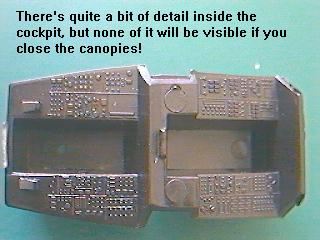 The 2 seats fit into a fairly well detailed cockpit tub, along
with 2 separate instrument panels (which look really nice), and a control stick
for the pilot. 2 crew member figures are also provided. There are no rudder
pedals, but very little of the cockpit will be seen anyway if the canopies are
closed.
The 2 seats fit into a fairly well detailed cockpit tub, along
with 2 separate instrument panels (which look really nice), and a control stick
for the pilot. 2 crew member figures are also provided. There are no rudder
pedals, but very little of the cockpit will be seen anyway if the canopies are
closed.
As is shown in one of the photos, there is a fairly large gap
between the 2 main upper and lower parts, and it's especially apparent near the
engine intakes. Additionally, these gaps run right through many of the panel
lines around the outer edges of underside of the model, and cleaning up these
relatively large gaps will most likely obliterate the surrounding panel lines.
Overall, these gaps are probably the most disappointing aspect of the model and
will require some work to remedy. 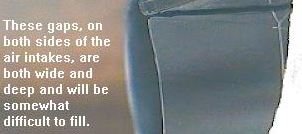 Additionally, all of the edges along the main
fuselage and wings have mold lines that need to be sanded smooth.
Additionally, all of the edges along the main
fuselage and wings have mold lines that need to be sanded smooth.
On to the D-21. Basically, it's small and looks like an engine encased in an aerodynamic housing! It's made up of 6 parts and though it has underside gap problems like the SR-71, they aren't nearly as severe here and it will be a lot easier to clean up. The trickiest aspect will be dealing with the part of the gap immediately behind the nose probe mounts. There isn't much room to work there at all. Also, as with the larger aircraft, all the edges will need to be cleaned up to remove mold lines.
 Finally, the D-21's transport cart. It's made up of 8 parts,
including 4 separate wheels. Aside from several prominent ejector pin marks and
minor mold lines, it will be a simple matter to clean up and assemble.
Finally, the D-21's transport cart. It's made up of 8 parts,
including 4 separate wheels. Aside from several prominent ejector pin marks and
minor mold lines, it will be a simple matter to clean up and assemble.
In conclusion, I'm somewhat disappointed with the huge gaps all around the underside of the SR-71. It will take a good amount of filler and sanding to correct, much more than I anticipated. I remember building this kit years ago, but at the time I wasn't very concerned with much more than gluing the parts together as fast as possible. With some effort however, I'm sure a fine model can result. It'll just take some effort, but sometimes, a little effort is worth it!
|
REFERENCES |
"The Oxcart Cometh" by William E. Burrows, Air & Space Smithsonian Magazine, February/March 1999
http://www.dfrc.nasa.gov/Projects/SR71/home.html
http://www.wpafb.af.mil/museum/modern_flight/mf35.htm
http://www.wvi.com/~lelandh/sr-71~1.htm
http://www.wpafb.af.mil/museum/annex/an11.htm (D-21 Information)
If you would like your product reviewed fairly and quickly by a site that averages over 2,600 visits a day, please contact me or see other details in the Note to Contributors.